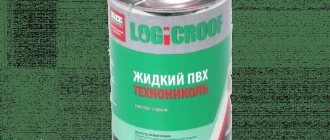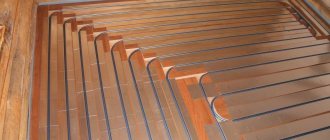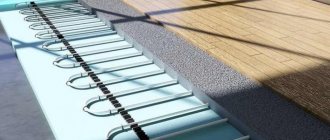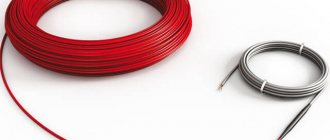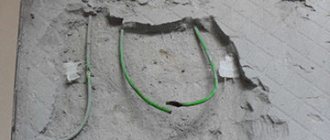Installation of hot water heating in the bedroom. How harmful is it? Is it possible to have heated floors in the bedroom?
Warm floors in the bedroom: pros and cons - can it be used, types of floors
Warm floors are used to maintain a comfortable temperature in the rooms. They are used for main room heating or for additional floor heating. Of course, the question arises: in what rooms are such structures installed? Is it possible to use heated floors in the bedroom? To get the answer, it’s worth studying all the pros and cons of such a solution.
Warm floors installed in the bedroom increase comfort
Types of heated floors
There are two energy sources for heated floors: heated water and electricity. The latter option is more often used for local heating, and the first – for autonomous main heating.
Attention! Water floors are a budget option for heating a room.
Water heated floor
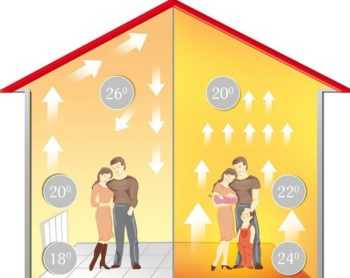
Heated floors in the bedroom with liquid coolant are considered durable and less expensive, but problems may arise during installation and maintenance. The structure consists of a pump, pipes and a boiler. There are several ways to install it:
- concrete screed;
- wooden floor;
- laying the finished floor on aluminum sheets;
- self-leveling floor
Electric floor
The installation of an electric heated floor covering in the bedroom is carried out using a special cable and mats made of heating elements. The latest technologies include infrared floors, which are based on rods and films. This floor is used for additional heating. To install an electric heating system, you must comply with some safety requirements:
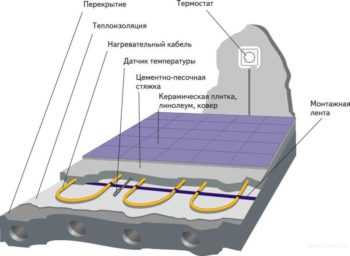
Electric floor installation diagram
- dry coating;
- installation of thermal relay;
- high-quality insulation and grounding.
Installation of the structure has the following nuances:
- To organize direct exposure, the warm floor is laid as close to the coating as possible.
- Cables and mats are thin, so they are used even in rooms with low ceilings.
- The system is capable of accumulating heat.
Attention! Cable heated floors have a long service life, if you choose the right floor covering - laminate is better suited.
Infrared films
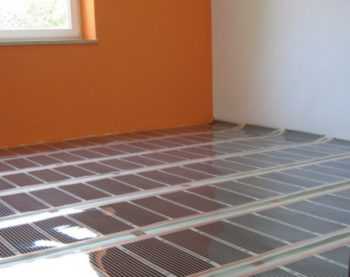
Heating the floor covering in the bedroom using infrared floors involves the passage of electric current with the formation of electromagnetic radiation that heats the finished coating. In this case, warm air moves across the entire area from bottom to top.
Structures made of mats and cables perform their functions only if the final floor covering is chosen correctly. For them, it is preferable to use laminate, and for film heated floors in the bedroom you can choose carpet, laminate, wood, or linoleum.
Pros and cons of heated floors in the bedroom
To understand whether it is possible to have a heated floor in the bedroom, it is worth knowing its positive and negative sides. The first include the following:
- A warm floor in the bedroom will forever eliminate damp corners and the development of fungi on the walls, as it eliminates the increase in humidity.
- It is impossible to get a burn from such a heating system, since the temperature on the surface is comfortable for walking barefoot - no more than 30 degrees.
- There is a self-regulation function using additional devices. They automatically control the temperature day and night.
- The installed heating system is invisible to outsiders; you can apply any design, which is limited only by your imagination.
- There are no drafts in the room.
- Savings on heating are up to 30%.
- It is easier to keep the room tidy and clean.
Disadvantages of underfloor heating:
- Comparatively expensive.
- Difficulty in installation, especially during ongoing repairs.
- Non-repairable.
- High requirements for the flooring that is installed on the heating system - it must have a high rating
pilorama-chita.ru
Warm floor: advantages and disadvantages of a heating system
Heated floors are used to maintain optimal temperature in rooms.
They are used for main room heating or for additional floor heating. Of course, the question arises: in what rooms are structures of this kind installed? Is it possible to use heated floors in the bedroom? To find out the answer, you need to learn all the advantages and disadvantages of a similar solution.
Heated floors installed in the bedroom increase comfort
There are two energy sources for heated floors: heated water and electricity. The final option is more often used for local heating, and the first one is used for independent main heating.
Attention! Hydraulic heated floors are an economical option for heating a room.
Same heat transfer in the room
A heated floor in a bedroom with a liquid heat carrier is considered durable and less consumable, but problems arise during installation and maintenance. The structure consists of a pump, pipes and a boiler. There are several options for its installation:
- concrete screed;
- wood floor;
- laying the finished floor on aluminum sheets;
- 3D floor
Heating floor
The installation of an electric heated floor covering in the bedroom is based on the use of a specialized cable and mats made of tubular-type heating elements.
The latest achievements of science and technology include film heated floors; they are based on rods and films. A similar floor is used for additional heat supply.
Laying scheme for heated floors
- dry coating;
- installation of a temperature relay;
- high quality insulation and grounding.
The installation of the structure has the following invisible points:
- The heated floor is placed very close to the coating to organize direct influence.
- The cables and mats are thin, so they can be used even in rooms with low ceilings.
- The system is capable of storing heat.
Attention! Heated cable floors have a long working life; if you choose a floor covering according to the rules, laminate is better suited.
Infrared films
Installation of heated film floor
Heating the floor covering in a bedroom using film floors involves the passage of electric current with the formation of electromagnetic radiation that heats the finished coating. In this case, warm air moves throughout the territory from bottom to top.
Structures made from mats and cables perform their own functions only if you choose the right finishing floor covering.
It is better to use laminate for them, and for a heated film floor in the bedroom you can choose carpet, laminate, wood, or linoleum.
To understand whether it is possible to have a heated floor in a bedroom, you need to know its negative and positive sides. The first include the following:
- A heated floor in the bedroom will completely free you from damp corners and the formation of fungi on the surface of the walls, as it eliminates the increase in moisture.
- You cannot get burned from such a heating system, since the temperature on the surface is comfortable for walking without shoes - no more than 30 degrees.
- There is a self-regulation function using additional devices. They automatically control the temperature regime day and night.
- The installed heating system is invisible to outsiders; you can use every design, which is limited only by your imagination.
- There are no drafts in the room.
- Savings on heating are up to 30%.
- It is easier to keep the room tidy and clean.
Disadvantages of underfloor heating:
- Relatively expensive price.
- Difficulty in laying, especially during ongoing repairs.
- Non-repairable.
- There are great demands on the floor covering that is installed on the heating system - it must have a high thermal conductivity rate.
Comfortable stay in the bedroom with floor heating
Many people worry that it is impossible to install heated floors in the bedroom, saying that they are only suitable for non-residential premises and where people rarely visit.
This statement is completely erroneous and appeared, most likely, after the use of a low-quality floor covering, which emitted bad odors when heated.
Nowadays, many coatings of the best quality, environmentally friendly and do not emit harmful substances are recommended on the market.
Therefore, the use of heated floors in the bedroom is safe and beneficial from an economic point of view.
The second myth that circulates among consumers is that underfloor heating is not used in the bedroom, since the heat coming from below (close to the head) is harmful to sleep and human health. After all, it is known that during sleep the room must be ventilated. The bedroom requires cold and clean air.
Having studied how a heated floor is installed in a bedroom, the pros and cons of installing it, everyone makes their own choice.
But you must always remember about the huge number of positive qualities and several disadvantages, which are offset by the comfortable conditions in the room.
At the beginning of a new heating season and during the next stage of rising energy prices, the topic of heating a home becomes especially relevant. How to save on coolants in winter without freezing? The question is more than burning in our time.
Succumbing to new trends, many consumers prefer installing heated floors instead of or along with traditional heating radiators. But is this the right choice? Let's look at the advantages and disadvantages of this method of heating a home.
The “warm floor” system, as the name implies, is an option for heating a house precisely by heating the floor. We know from school physics lessons that warm air has the ability to rise from bottom to top.
Have you noticed that on the second floor of a private house in winter it is always warmer than on the first? (This does not apply to the attic.) And in anatomy lessons we were told that a person begins to freeze if his feet are cold.
“Keep your feet warm and your head cold,” remember?
Why this basic knowledge was not taken into account earlier in the construction of both private and multi-storey housing, we will not understand.
It so happens that a radiator heating system, which is significantly inferior in terms of comfort to a heated floor, is currently installed in most houses in the post-Soviet space.
Most likely, the level of technological development simply did not allow the introduction of heating of this type of housing into practice previously.
If we talk about a country house, then at the construction stage the owner himself chooses the method of heating his home.
And replacing standard radiators in a private house with heated floors is not a problem, if only there was money.
If desired, apartment owners have the opportunity to install a heated floor as an additional or main source of heat when the radiators are turned off.
Types of heated floors
Any “warm floor” system is a combination of heating elements located under the floor covering and uniformly heating its entire surface.
Today, there are two possible options for implementing such a project: electric underfloor heating and water underfloor heating.
•In the first case, heat comes from heating special conductors during the passage of electric current. In the second, the coolant is heated water circulating in a system of pipes, metal or plastic.
However, due to the peculiarities of the installation and operation of a warm water floor, its installation in apartment buildings is not yet technically possible.
READ MORE: Installation of concrete floors - work procedure
But it has a number of advantages over electric ones when installed in country estates.
An electric heated floor can be successfully installed both in an apartment and in a private house, for example, on a closed veranda or balcony, if there is any need for it.
Types of electric heated floors differ in the type of heating elements.
The modern market offers underfloor heating systems such as cable, film (infrared), and thermomats.
Water heated floors also have their own subtypes, differing mainly in installation technology:
- Concrete technology (heating elements are mounted under a monolithic concrete screed).
- Laying technology (performed by laying several layers of materials of different types).
The advantages of both electric and water heated floors include the fact that this type of heating:
- It does not take up square meters of usable space at all, which allows you to implement the most interesting design projects.
- Eliminates the presence of drafts in the house. With conventional batteries, heat, so to speak, “walks” through the rooms. The warm floor evenly lifts it up. This makes life much easier for asthmatics and allergy sufferers.
- Does not dry out the air, providing optimal humidity.
- During operation, heat is transferred by radiation rather than by convection (air heating), which is more favorable for the human body.
- Much faster, compared to traditional radiators, it warms up a room of any size. This is of great importance for residents of private estates.
- The heating elements of the system are hidden and do not spoil the interior of the room.
In addition, if we talk about the specific features of an electric heated floor, it is advisable to install it because:
- Installation of an electric heated floor is the key to the well-being of the owners during the heating season. At foot level, the system maintains a temperature of 24 degrees Celsius. In the area of the body - 20, and in the head - 16 degrees. According to scientists, this is the optimal temperature regime for a person’s comfortable well-being.
- This temperature can be maintained automatically throughout the entire period of operation. This allows the rooms to be heated evenly. Modern electrical “warm floor” systems are equipped with special regulation sensors that allow you to “adjust” the temperature regime to the individual characteristics and life schedule of the owners. When you plan to return home, the system will raise the room temperature according to a given schedule; when you are not at home, it will work with less heat output.
- In addition, the thermostat allows you to warm up individual rooms more or less. That is, individually set the temperature regime for each room. Old radiator heating systems do not allow this in principle.
- High reliability. According to the manufacturers, an electric heated floor without major repairs can be used for as long as the house itself.
- Electric heated floors can be easily installed under most modern floor coverings. Considering that there are several types of systems on the market, it can be installed in any home.
Is it possible to have heated floors in the bedroom?
Is it possible to have heated floors in the bedroom?
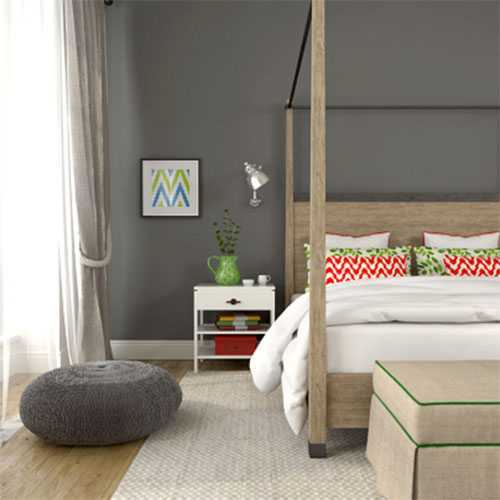
There is an opinion that heated floors in the bedroom are harmful to health. Opponents of these systems argue that underfloor heating increases the temperature in the room, interferes with comfortable sleep and emits electromagnetic waves that are harmful to health. There are no rules prohibiting the installation of heated floors in the bedroom. However, to be convincing, let's look at the issue of their safety from different angles.
Safe temperature
Heating the floor slightly increases the overall air temperature in the bedroom, this is a fact. However, in order to make the indoor microclimate comfortable, simply do not exceed the floor temperature level recommended by SNiP of +24-26°C. The thermostat allows you to adjust the temperature, and if you overheat, you yourself will feel that it has become uncomfortable under your feet.
For you to sleep comfortably, the room must be cool. Recommended air temperature +18-20°C. If you want to more accurately control the microclimate in the bedroom, use a heated floor thermostat with an air sensor. It will limit floor heating, focusing on the maximum permissible air temperature. If the controller is also equipped with a programming function, you can set it so that the heating turns on only in the morning.
Electromagnetic safety
The level of electromagnetic radiation in modern cables used in heated floors is negligible, so there is no need to worry about safety in terms of radiation. For reliability, choose systems based on a two-core cable - its radiation level is several times lower compared to single-core cables. At the same time, installing two-core cables is much easier.
Unpleasant odor from the coating
Poor-quality floor coverings emit unpleasant odors when heated above +30°C. Therefore, choose the most environmentally friendly coatings that are combined with heated floors, and do not exceed the maximum permissible temperature recommended by the manufacturer. Information on the compatibility of the coating with heated floors can be found on its packaging. The maximum permissible heating level for parquet, laminate, linoleum, carpet: +26°C.
On our website you can buy safe two-core heated floors suitable for all rooms. Cable ties and heating mats are available, as well as thermostats for heated floors.
energymarket.ru
Is it possible to have electric heated floors in the bedroom?
28.02.2018
Sooner or later, repairs reach the bedroom. And a reasonable question arises: is it possible to have heated floors in the bedroom, to what extent will they be needed for main or additional heating?
To answer this question, let's analyze the pros and cons of such a solution. But first, let's clear up the myths associated with this topic.
Myths about heated floors in the bedroom
The first common opinion is that proximity of the head to the heated floor covering is harmful to a person. This is not true, because even heating cables have electromagnetic radiation several times lower than normal, and infrared rods and film, on the contrary, benefit health and well-being.
The second myth: due to the heating effect, the finishing coating emits harmful substances, so heated floors can only be installed in non-residential premises where people spend little time.
However, when heated to a temperature comfortable for humans, none of the high-quality flooring materials emit toxic substances, so this opinion is also erroneous. The main thing is to select high-quality coatings that are safe for the human body.
And the third popular misconception: it is impossible to relax in a room with the floors turned on, since the temperature is higher than normal and the bed is quite low. This may be true, but only in one case - if the heating works without restrictions and stops.
But every specialist, when discussing the model and installation of heated floors, will definitely recommend using a thermostat. And this regulator will maintain exactly the temperature you specify. Therefore, comfortable conditions will depend entirely on your needs and the proper use of the temperature controller. It is also recommended to periodically ventilate the bedroom to keep the air fresher.
Strengths of heated floors
- The heating system can be installed under almost any floor covering, including parquet, laminate, tile, linoleum and carpet;
- Using heated floors in the bedroom reduces the humidity in the room, which will eliminate dampness in the corners and wall mold;
- With proper installation and high-quality components, it is quite possible to save up to 30% on heating costs;
- The temperature of the heated floor covering is comfortable for the feet and does not exceed 30⁰C. Therefore, the risk of getting burned is reduced to zero;
- The heating system uses special devices - thermostats for heated floors, which automatically regulate the temperature during the day and at night. And to ensure there is no overheating, there are floor models with self-regulating properties;
- Thanks to thoughtful air circulation and heat exchange, drafts will not appear in the bedroom;
- Since the heating elements are placed under the finished floor, they are not visible to guests and owners, which means that an almost unlimited number of interior ideas can be implemented;
- Fluff and dust are almost not carried by the currents of air heated by the floor, so it will be easier to clean up.
Unobvious nuances of heated floors
Any product has subtleties that need to be taken into account when assessing all the pros and cons. Electric floors confirm this rule. They have the following features:
- Additional expenses. This includes not only one-time costs for the purchase of devices and materials, but also monthly energy costs. However, with proper selection, installation and use, most Russian citizens can afford a modern floor-type heating system.
- Time, effort and knowledge for design and installation. But this is not surprising - any new project requires attracting resources.
- The relative complexity of installation for some work (for example, pouring a concrete screed, laying porcelain floor tiles).
- Increased requirements for the finishing coating that will be laid on top of the heating elements - it must have high thermal conductivity.
Now, when selecting and organizing a heated floor, you can take into account its features and weed out myths - then the bedroom has every chance of becoming an even more comfortable room.
If you need advice, call us and we will answer all your questions!
www.spb-teplypol.ru
Is it possible to have heated floors in the bedroom?
Is it worth installing heated floors in bedrooms?
If you mean electrically heated floors, then it all depends on your financial well-being (will you be bothered by paying for electricity) and on the way your family walks around the house (always in slippers or barefoot). We don’t have heating in the restroom, but I like to walk around the house barefoot, and when you go from warm floors to cold ones, the feeling is at least not pleasant, to say the least. Conclusion. if you are making electric heated floors and like to walk around the house barefoot, it is better to heat the floors in all rooms.
the author of the question chose this answer as the best
add to favorites link thank
Similar case: Second floor, water heated floor. Despite the fact that all my relatives trampled on my ears so that I would install heated floors only in the bathrooms, hallway and kitchen, I gritted my teeth, sent everyone mentally you know where and made heated floors on the entire second floor. AND I WAS DAMN RIGHT! If you want to walk barefoot all year round, if you have small children who spend almost all their time at home on the floor, the floor needs to be warm EVERYWHERE! Do you think that if it’s on the second floor, it won’t freeze? Hell no! No, of course it won’t be covered with frost, but it will be very uncomfortable to move from a heated area to an unheated one. The end result is either walking in slippers and your feet will sweat on the warm floor, or walking barefoot and freezing in the bedroom. This is the first winter that we live in a new house on this very second floor. I can say one thing - without heated floors IN ALL ROOMS, my little ones (1.5 and 4.5 years old) and I would definitely not have survived. Yes. And about humidity. I don’t know about anyone, but we don’t experience dry air in our rooms. Quite the opposite: sometimes condensation appears on the walls (they didn’t have time to insulate the entire house from the outside and the uninsulated walls are cooler).
Z.Y. I’m looking forward to my father-in-law’s arrival so I can rub his nose into the warm floor and convince him that he’s been messing with my mind all summer in vain.
add to favorites link thank
If it is possible to install a heated floor, it should be done EVERYWHERE. Especially in the bathrooms. Heated floors are adjustable, so you can simply adjust them for comfortable heating. Don’t forget that heated floors also prevent dampness of the bed (mattresses) that absorb moisture from the air during the de-season periods (autumn, spring), which cannot be achieved with radiators! If you still don’t want to heat the bed, then you can simply bypass this place and warm only the area free of furniture. Ideally, I conduct it separately. through a separate comb the location of the beds and customers turn on the heating
polaks.ru
Warm floor: let's weigh everything
Even in ancient times, a person, creating a living place for himself, tried to protect it as much as possible from enemies, predators and weather conditions, and to make it cozy and comfortable. This is still the case today: in countries where there are snowy and frosty winters, heating the home and work premises plays a very important role in terms of convenience and coziness.
READ MORE: What you should not leave in an apartment when moving and why signs and practical tips
Multi-storey buildings and private sector buildings, built during the Soviet Union, were equipped with radiator heating systems.
Such a system was easy to install and repair; at any time, the owners could increase the number of sections in the battery. Owners of private housing could regulate the heat by changing the parameters in the gas boiler.
Residents of high-rise buildings depended on centralized heating, often freezing in cold weather or opening windows on warmer days, suffocating in the apartments from the heat. Thermal comfort during construction was not in the foreground.
Since winter in Russia is still a very cold season, modern construction methods offer the installation of underfloor heating.
And the house is warmer, and children can safely play on the floor without fear of a cold, and it’s pleasant to walk on the warm surface, like on summer sand. They write and talk a lot about warm floors.
This is a whole system that allows you to heat your home, in which heat is distributed evenly throughout the room. The heat carrier is located in the floor.
If it is water based, then these are pipes, if electrical, then it is cables. Water heated to forty-five degrees undergoes regular movement in the pipe; a cable connected to the network performs the same heating function. Electric heat is regulated by a thermostat, water heat - using sensors on the boiler.
If you haven’t settled on any option yet, let’s look at the positive and negative aspects of such coverage together.
Pros:
- Save money on heating costs (up to thirty percent). The warmer the room, the less heat is spent heating it. If our feet are warm, we perceive even low temperatures as comfortable. Heat, according to the laws of physics, rises. That is, without heated floors, the warmest place in the apartment is under the ceiling. With heated floors, the temperature is even everywhere.
- No special equipment is required for installation; faults can be easily fixed.
- If installed correctly, such a floor can last up to fifty years.
- The appearance of a heated floor does not differ from the usual one and does not attract attention like radiators.
- Warm air rising from the floor creates an obstacle to the formation of drafts.
- Ideal conditions for children's games. You can play wherever you want without the risk of catching a cold.
Minuses:
- Pleasure is expensive. The cost and installation, of course, will pay off someday, but money is needed now.
- This is not a simple routine repair; you will have to raise the floors a few centimeters, this is not always realistic. Now, if your construction has just begun, this is your option!
- You will have to think about floor coverings, because, for example, laying a warm, dense carpet on such a floor will ruin all your efforts, and there will be no benefit from the floor.
- Difficulties almost always arise with repairs. The floor heating system in the rooms is common; sometimes it is difficult to determine the place where the breakdown occurred. But if you spare no expense on installation and invite real professionals for this, and follow the operating rules, there shouldn’t be any problems.
- All furniture should be raised above the floor for free circulation of heat; if it is not made from natural materials, there is a possibility of releasing small but constant concentrations of harmful substances from it when heated.
- The flooring may warm up slowly (from three to five hours), first the concrete in which it is built will heat up, and then the covering and the air. But when the system is turned off, cooling occurs just as slowly.
- If you spend a long time in a room with warm floor heating, exacerbations of diseases of the lower extremities are possible (for example, varicose veins - a vascular disease of the veins).
- Installing water heated floors in city apartments has technical difficulties and requires special permits.
Half a dozen years ago, film heated floors were a unique phenomenon; today, infrared film floors are used to create comfortable zones in residential buildings, apartments and offices. Popularity and demand have created competition and, accordingly, advertising and product reviews, which can be true or fictitious.
In an electric infrared film heated floor system, the main thing is the presence of a thin heating carbon film, which, when connected, begins to emit infrared rays and anions. The radiation comes from carbon paste applied in parallel, straight or curved strips.
On expensive films, the paste is applied in a uniform layer.
To ensure that the heat transfers to the flooring and not the neighbor's ceiling, it is necessary to use a heat-reflecting underlay.
If you can still lay the materials yourself, we recommend inviting a qualified electrician to connect to the network.
Most markets now offer Korean-made heating films. This film is of good quality and reasonable prices, which, unfortunately, depend on the value of the currency.
The market can offer products made in Ukraine, the Czech Republic, the USA, China and, naturally, Russia. Increased competition expands the choice, but at the same time, the company, while presenting the quality of its product, often speaks unflatteringly about competitors’ products.
This material warms up in literally a matter of minutes and can be quickly dismantled if necessary.
But, covered with a laminate, a film floor still cannot be the main heating system in the room, since the quickly heating material cools down just as quickly if the system is turned off.
By the way, the film mesh can be attached not only to the floor. It is perfectly installed on walls, ceilings, and curved surfaces.
Users come up with a lot of things: they heat containers with honey, heat various equipment, the bottom of a home pond, build greenhouses, and much more.
Many sellers of cable floors tell buyers a horror story that film floors ionize the room with negative particles.
Some radiation does indeed come from the film itself, but the laminate, tile or linoleum covering it on top does not allow it to pass further.
You can even make a mobile system, when the heating film with a backing is laid under the carpet, and placing the wires and thermostat in a safe corner allows you to use it during the cold season, removing it for the summer.
When installed correctly, a fiberglass reinforcing mesh is used and must be nailed to the floor underneath. The tiles are attached with a special glue, the layer of which is at least one and a half centimeters.
Some buyers suspect that sellers are still hiding something, or at least not discussing the shortcomings.
The film flooring system has a large number of hidden contacts, which can be considered a disadvantage.
Before laying, it is imperative to check the operation of the system and subsequently supervise the installers of the flooring, be it tiles, laminate or anything else.
Peeling of tiles if they are installed incorrectly can also be considered a disadvantage, but this will not happen if you entrust the work to a trusted specialist.
Drawing a line under the considered advantages and disadvantages, we note that electric heating is more appropriate in small areas: kitchen, bath, toilet.
For large rooms, we suggest that you still choose a water-based floor, especially if it is the floor of a country house.
READ MORE: Waterproofing the bathroom floor - we do it ourselves
Watch a video about what type of heated floor to choose and what are the positive and negative aspects of installing heated floors:
Please give a normal explanation of WHY you can’t have a heated floor in the bedroom?
Why not? There are other ways, and there are two types: electric and water. If you have hot water in your house, then water is better, it’s cheaper to pay for it. The only reason why it couldn't be done was because of electromagnetic radiation. So now everything has been secured for a long time, see https://www.rmnt.ru/story/decoration/15865.htm. Well, as for laminate or linoleum, it’s up to you to decide. I would of course choose laminate, it is better suited for this type of floor construction.
Where did you find that you can't? I have heated floors in my bedroom, it’s very comfortable
So, ask those who say it’s impossible.
Why not? I would only do it zoned: under the window and on the sides of the bed - it seems to me quite comfortable to get up in the winter morning on a warm floor. It makes no sense to make it continuous; why do you need heating under the bed or chest of drawers?
Well, since floor coverings went out of fashion, heating came in... If you like it, just do it for some reason.
because it's the second floor! xoxo
You can have a heated floor in the bedroom, but not everyone likes to sleep where it is very warm. I often have a headache.
Some believe that dust rises with warm air and this causes asthma and other diseases, and heated floors are therefore harmful in general, and, apparently, especially in the bedroom. But as a doctor I want to say that this is some kind of nonsense. So if you want, do it.
I don’t know where this story came from, but many reasonable-looking people repeat like sheep a lot of different things about heated floors. The only 2 reasonable factors: - apparently someone tried (and more than one) to make a water-heated floor, connecting it to the existing heating supply system - the result is very sad. — an electric heated floor is a source of an electromagnetic field, constantly being in which, to put it mildly, is not good for health. And in the bedroom we immerse ourselves most fully in it, lying for a quarter of our lives at a low altitude. It is unlikely that your bed is more than a meter high. Single-core heating cable is the most phony. There is no desire to write more letters about nonsense around heated floors
Yes. . People also have a hard time with physics - warm air rises, dust goes with it. But in your apartment you can do anything. Even under the bed and cabinets you can easily create a warm floor.
touch.otvet.mail.ru
Warm floors in the bedroom - pros and cons of installation
The heated floor system is popular in the construction market. This is an effective way to improve the microclimate during the cold season and make it comfortable.
It was a low-temperature and low-power system, far from ideal. It was used as a preheater for the room, as an additional source of heat . Over time, the system has been improved, new technologies for manufacturing equipment and components have appeared. How rational and safe is it to install heated floors in the bedroom? All the pros and cons of its use in an area intended for sleep and rest should be analyzed.
Warm floors in the bedroom - pros and cons | All about heated floors
Warm floors in the bedroom - pros and cons! Which floor heating system should I buy for the rest room and what restrictions does the presence of a heated floor impose on the choice of flooring? Answers to these and other questions in this review.
The bedroom is the room in which comfort and coziness come first among other needs. After all, you really want to enjoy your vacation and relax as much as possible in your warm bed. But will relaxation be complete if, out of pleasant bliss, you have to put your feet on the cold parquet? Of course not!
Therefore, more and more people are seeking to install modern heated floors. This blessing of modern times is the best assistant to the heating system. After all, a pleasant warmth emanates from the surface, heated to a comfortable temperature. But, given the specifics of floor coverings in the bedroom, the choice of floor heating technology should be considered carefully.
Which heated floor to choose for the bedroom?
A bedroom with carpet, parquet or linoleum is a classic of the genre in the world of interior design. It's hard to imagine this room with tiles or tiles underfoot. Today, there are 3 main methods of organizing floor heating:
- Installation of cable heated floors.
- Using thermomats.
- Infrared heating.
Cable underfloor heating is a system with the most complex installation method. If you are doing a major renovation with a floor screed or are building your own house, then there will be no problems with its installation. Among the advantages of this method, it is worth highlighting accessibility (the cable is inexpensive), high efficiency, uniform floor heating and fire safety. But the durability of the system directly depends on the quality of the screed. So, if the concrete is not allowed to gain strength and the decorative coating is applied too early, it may crack, damaging the cable. Also, this technology is not suitable for those who have started cosmetic repairs.
Thermomats are heated floors under tiles, consisting of a thin mesh material with a thin cable laid on it. Heating mats are easy to install, as they are already ready for use. The main advantage of this method is the ease of installation and small thickness. But mats are easily damaged and have strict restrictions on the type of coating with which they can be combined. This technology is used with tiles, porcelain stoneware, mosaics, tiles and natural stone. It is better not to use laminate, carpet and other materials with this type of heated floor.
Infrared heated floors are an innovative technology characterized by safety and excellent performance characteristics. The coating is made in the form of a film with a thin layer of carbon printed into it. Installation of this system does not require specific preparation and can be performed even when redecorating the premises. It is enough to spread the film, perform simple manipulations to connect it, and place the selected floor covering on top. No strings attached or expectations – just warmth and comfort in your bedroom. The only drawback of this technology is its high cost.
The conclusion is obvious: if you want to install a heated floor in the bedroom, it is better to choose an infrared heated floor model. It easily combines with conventional decorative coatings, is durable, safe and highly efficient.
Is infrared heated floor harmful?
Buyers think about this almost more often than about the dangers of LED lamps. Let's dispel this myth.
The world's leading scientists, having conducted a lot of tests and research, were able to prove that this technology is not only absolutely safe, but also useful. After all, heat does not accumulate near the ceiling, but rises evenly, warming up the middle part of the room and cooling towards the top. You can forget about stuffy rooms and lack of fresh air.
Moreover, infrared waves have healing properties. Delicate radiation with the same parameters is actively used in medicine and cosmetology. It leads to improved immunity and normalization of metabolism, natural renewal of the skin and a reduction in cellulite. Also, infrared radiation has bactericidal properties and helps relieve stress. Spending the night in a room with such a heating system is like visiting a cosmetologist, going for a massage or soaking in an infrared sauna.
Myths about the dangers of heated floors
There are several legends about this modern benefit, the absurdity of which has already been proven. The most common myths are:
- The floor is electric.
- Electromagnetic radiation leads to illness.
- The coating emits ultraviolet radiation.
The floor is electric. This myth arose a long time ago and only for the reason that electricity is involved in the heating process. But tell me: does a lamp, laptop or mobile phone get electrocuted? Of course not, because the current-carrying elements in these devices are isolated. This also applies to underfloor heating elements. They have several degrees of protection: from insulation to special sensors that turn off the system if overheated or damaged. The risk of getting an electric shock from the floor is reduced to zero.
Electromagnetic radiation leads to illness. This myth is inspired by the fear of everything new. In fact, the radiation from the floor is an order of magnitude less than from the TV.
The coating emits ultraviolet radiation. This myth arose from the popular comparison of IR emitters to the sun. But this coolant is capable of producing only a useful spectrum of radiation in the infrared range, and not ultraviolet waves. Otherwise, the heater would not be called infrared, but ultraviolet (see figure below).
In general, if you decide to have heated floors in your bedroom, then you should give preference to an infrared heat source. This way you will get comfortable and safe coverage.
elektrika-ok.ru
Warm floors in the bedroom - pros and cons of installation
The heated floor system is popular in the construction market. This is an effective way to improve the microclimate during the cold season and make it comfortable.
It was a low-temperature and low-power system, far from ideal. It was used as a preheater for the room, as an additional source of heat . Over time, the system has been improved, new technologies for manufacturing equipment and components have appeared. How rational and safe is it to install heated floors in the bedroom? All the pros and cons of its use in an area intended for sleep and rest should be analyzed.
In which room should I install a heated floor?
In which room should a warm floor be installed? Text: Anna Filonova With the arrival of summer comes the most favorable time for construction and repair work.
Just at this time, without sacrificing comfort, you can start improving the heating system by adding a warm floor to it. The “warm floor” system is located between the base and the floor covering. Under it there is a layer of thermal insulation materials to prevent heat from passing down. The heating elements are covered from above with a concrete screed, wood, polystyrene or simply a floor covering. Heating elements raise the temperature of the floor surface, from where the heat spreads throughout the room. The first question that needs to be answered: which floor heating option is the best solution for your apartment? Perhaps you are already choosing between a “water” floor (in which the coolant is water or another liquid that transfers its heat to the floor covering) and an “electric” floor (for which a heating cable with a high-resistance alloy core is laid under the flooring). However, for interiors, an “air” floor (with hot air as a coolant circulating through an air duct system) and an “infrared” floor on carbon rods have also been developed - the most modern offering on the market (electricity is supplied to carbon rods, which heat the flooring). Another type of infrared floor (light version) is a warm floor made of thermal film with carbon elements, to which electricity is also connected. Without dwelling in detail on the analysis of the pros and cons, we will summarize briefly: a water floor is economically beneficial for use as the main heating; it requires time for laying (especially if the floor is filled with concrete screed) and crew work, but is most effective when used over large areas . A popular option for additional heating is an electric floor: it does not raise the floor level as much and does not threaten leaks, in addition, it provides faster heating compared to a water floor. On the other hand, it is accompanied by the presence of an electromagnetic field, which is not very favorable for the human body. Air flooring is extremely unpopular in Russia, as it requires special air ducts, and the gas cools quickly. Infrared floors are the “healthiest” option currently available, since electromagnetic radiation is minimized, but it is more expensive than others. In addition, an infrared floor does not require a long wait before being put into operation. The next stage is the selection of rooms in which heated floors will be located. If we are talking about warm floors as the only heating system, it is clear that they will be in all rooms. But when used as a supplement to the main heating, it is necessary to determine in advance where to lay the heating elements. It is laid in bathrooms and bathrooms so as not to stand on cold tiles and reduce overall humidity. Black fungus will not form on the tiles and curtains in the bathroom, and condensation will no longer accumulate on the walls. When drying clothes, a warm floor in the bathroom or utility room significantly speeds up the drying process. Here the appearance of a heated floor is completely justified. The second most functional place for heated floors is a glazed balcony or loggia. Heating helps to quickly turn them into an additional room or a winter garden. Warm floors in a nursery are no longer so clear-cut. Of course, children prefer to crawl, sit and lie on the floor. But for the floor in a nursery, “warm” coverings are usually used: children’s carpet, cork, solid or parquet boards. They do not require additional heating and are heat insulators, which will significantly reduce heating from below. To make a decision regarding the kitchen, you will have to weigh the pros and cons. If there are tiles on the floor, and small children spend a lot of time here, then a warm floor will be a good help. If the kitchen has laminate flooring, the children have grown up, and the ventilation system perfectly gets rid of moisture, then a warm floor will only dry out the air. The flooring in the bedroom is usually made, as in the nursery, from “warm” materials. In addition, according to the recommendations of doctors, a person rests better in rooms with a temperature reduced by several degrees. Thus, in the bedroom you can do without a heated floor. In the living room, heating elements are necessary if different types of flooring are combined. In this case, a warm floor is made, for example, under a porcelain stoneware path that separates the zones of the room. myremdom.ru
Types of heated floors
There are two energy sources for heated floors: heated water and electricity. The latter option is more often used for local heating, and the first – for autonomous main heating.
Attention! Water floors are a budget option for heating a room.
Water heated floor
Warm floors in the bedroom with liquid coolant are considered durable and less expensive, but problems may arise during installation and maintenance. The structure consists of a pump, pipes and a boiler. There are several ways to install it:
- concrete screed;
- wooden floor;
- laying the finished floor on aluminum sheets;
- self-leveling floor
heated floor in the nursery | Algorithmsynthesis
All children love to play on the floor and spend a lot of time playing. Therefore, many parents have a desire to install a “warm floor” system so that the child is warm and feels comfortable. Would you like to make a warm floor in your children's room, but do you doubt its safety or harm? This is what the conversation will go on, or rather the safety of the electric underfloor heating system. If you don’t yet know what it is, then I advise you to read the article - what is an electric heated floor and what components does it consist of. Cable heating sections will be discussed; these also include heating mats installed directly under the tiles, thanks to which you get a thin warm floor. Also, now there are many film heated floors for laminate, as well as the opportunity to make a wooden heated floor in a frame house. We'll talk about them later.
Is it possible or not to have a heated floor in a children's room?
One of the first questions when deciding to install a heated floor is the safety of the heated floor against electric shock. The child will constantly be on the floor in which the cable with running electrons is laid. And if electrons run along the cable, it means there is electromagnetic radiation. What kind of electromagnetic radiation from the heated floor system will be in the children's room? Is there any harm from an electrical underfloor heating system?
Is it possible to install heated floors in a children's room?
Let's look at a few main points.
1. What are the safety requirements for heated floors against electric shock?
The requirements for the “warm floor” system are exactly the same as for all apartment equipment according to today’s standards.
The power supply for the “warm floor” system should be supplied by a separate cable, and not connected to lighting or sockets.
The heating cable must be shielded. Although today all well-known ones produce and sell shielded heating cables. At one time they sold cheap Bulgarian heating cables; they were not shielded, and even during their operation a hum could be heard. Such a warm floor is not something to be used in a child’s room; it cannot be used at all. By the way, it was later banned from selling in Bulgaria. But it’s still better to pay attention to this point when purchasing a heated floor system.
An apartment, private house or cottage must have a grounding connection (grounding wire). In newly built houses and apartments it is present, but in old ones, most likely, it is absent.
Naturally, there should be an RCD in the shield. The RCD is designed to protect anyone, no matter an adult or a child, from electric shock. I especially recommend installing it if you have small children. Remember yourself, probably everyone has a story from childhood with his majesty electricity. But it's good when everything ends well.
As you can see, there is nothing special; the requirements for heated floors are almost the same as for a washing machine or refrigerator, with the exception of shielding.
2. Is there any harm from electromagnetic radiation from heated floors?
Almost everyone asks this question when buying a heated floor, especially when it comes to a heated floor in a children's room. Electromagnetic radiation refers to radiation from an electric field and a magnetic field.
The electric field strength is safe for health, because the value of V/m units is 2 orders of magnitude less than the maximum permissible.
Magnetic field strength. The natural background of the earth is approximately 50 µT, with 100 µT being normal. Now let's look at the parameters of a shielded two-core cable, this parameter is 0.2-0.5 µT. For a single-core shielded cable this parameter is 2-3 µT. Thus, the magnetic field parameters of single-core and two-core cables are many times lower than the ground background parameter. However, for a children's room you need to use a two-core shielded cable. Manufacturers recommend using a two-core cable in rooms with constant presence of people, and in rooms where there is no constant presence, you can use a single-core cable.
The conclusion is simple - there is absolutely no harm from the electromagnetic radiation of a heated floor. A mobile phone or a modern refrigerator is more harmful than a “warm floor” system.
3. What flooring do you use in the children’s room with the “warm floors” system?
In general, choosing flooring for a child’s room is a responsible matter, and for a warm floor it is doubly responsible. You can read about their environmental friendliness in the article - floor coverings for the home and at the same time it will be useful to know the environmental friendliness of various types of wallpaper for an apartment.
There is one more point that you need to pay your attention to – floor covering. The heated floor covering can be ceramic tiles, laminate, linoleum, carpet, parquet. Apart from tiles, all other coverings must be marked for heated floors. The heated floor screed heats up and transfers heat to the floor covering, and it is from the floor covering that heat is transferred into the room. The floor covering is heated to a certain temperature.
4. What should be the temperature of the heated floor in the children's room and in general?
Everyone chooses an individually comfortable floor temperature for themselves. But it should be between +19 and + 26 degrees. The temperature of the floor covering below or above these parameters will be considered uncomfortable by international standards. So, if, for example, in a children’s room the floor covering is laminate, and you thought that the room was cool and naturally set the “warm floor” system using the regulator to maximum. What happens next? And then everything is simple, the laminate begins to heat up above its allowed temperature. As a result, you are exposed to harmful fumes from the coating itself. So they can harm your child. It’s good if, when buying a heated floor, you said that the covering would be laminate, and they selected a system for you that, despite your best wishes, will not heat the floor covering above + 28 degrees.
I often hear from people whose floors heat up to 50 degrees and they consider this a good indicator. I think this floor temperature is definitely harmful to health.
Using an example, I showed exactly that factor that depends only on the user of the “warm floor” system. It doesn’t matter whether your floor heating is water or electric, you must always take into account the characteristics of the flooring materials, then the warm floor will be 100% safe for your health.
Of the above factors, a warm floor in a children's room is absolutely safe and harmless for your child. This is the answer to the question - is it possible to have heated floors in a children's room? If you are making renovations in a children's room, then on the website, under the design in the children's room design algorithm, you will be able to find useful information for yourself.
Sincerely, Vladimir Kulitsky.
I think you might be interested in this:
Did you like the article? Don't want to miss new articles on construction and renovation? Then subscribe to RSS or email on the FEEDBACK page and receive new articles instantly!
Technical features of heated floors for the bedroom
Modern technologies in construction make it possible for a heated floor system to replace central heating in a home. In this case, the surface affected by heating must be at least 70% of the total area. If the furniture is densely arranged in the room, this condition cannot be met.
If in the future you plan to have a large number of items on the floor, then this option will not work and you will have to look for other ways to heat the room.
It is not necessary to lay pipes over the entire area of the bedroom; you can decide in advance on the places where large furniture will be placed (bed, closet) and do not insulate the floors in these places. It is not recommended to change the location of large elements after installing the system. Or do the opposite: decide where exactly you need heating and insulate these areas.
The recommended specific power of underfloor heating for additional heating of the room should be 110-140 W/m2, this will allow maintaining a comfortable temperature in the bedroom during the cold season and off-season. For the main heat source, this figure should be from 150 W/m2.
The heated power of the floor should depend on which floor the bedroom is located on.
First floor. This is the location of the room closer to the ground, so the power must be increased to normal. An important factor is the presence of a cold basement. On average, this figure is 140 W/m2.
Second floor and above. Here it is also necessary to calculate the comfortable power; compared to the first floor, it will be less. The recommended value is 120 W/m2.
Typically, the temperature of a heated floor is 26 degrees, but if desired, it can be varied and the required temperature regime can be set.
Why is it not recommended to have warm floors under cork?
The thing is that cork itself has good heat transfer, and at the same time it is a dense structured material that will poorly transmit heat from heating elements.

Imagine a situation if you choose a water floor as a heater, and suddenly it leaks, then the cork covering will be damaged, and you will need to completely replace it, if it is, of course, a solid canvas.
If you use an infrared or electric element, then trouble may occur here too, due to the fact that in these types the temperature regime cannot be exceeded 26 degrees, otherwise the coating will simply begin to collapse, it will dry out and cracks and deformation will appear.
Also, due to its heat resistance, the coating will not completely transmit the body, and the heating elements will take about an hour for you to feel the warmth of the floor.
Cork coverings
Technical traffic jam
Today, the cork flooring market is very diverse. The most affordable variety is technical cork.
Cork in rolls
Technical cork is produced and sold in rolls. It is most often used not as a full-fledged floor covering, but as a backing for laminate or linoleum. Thanks to its structure, technical roll cork perfectly hides defects and unevenness of the base, and also provides excellent thermal insulation.
Note! Due to the high thermal insulation characteristics of cork, it is not recommended to install a heated floor under cork (especially under an adhesive coating). There shouldn’t be any special problems, but such a floor warms up in about 40 minutes instead of the usual 10-15.
In addition to rolled technical cork, there is also granular cork. It can be used as thermal insulation, for example, by filling cavities between floor joists.
Cork tiles
Another option for cork flooring is adhesive cork tiles. The most common adhesive coverings are square in size 30x30 or 45x45 cm, but other models can be found.
Tile sticker
The top of such cork tiles is coated with a protective compound. On the one hand, it protects the cork from abrasion, and on the other hand, it prevents the foot from sliding along the cork. This coating also protects the cork from water, so you can lay cork tiles in wet areas, for example, in the bathroom or kitchen.
A separate group of cork tiles is self-adhesive cork. An adhesive composition is applied to the underside of such a tile, covered with a protective film.
Lock plug
Well, and perhaps the most expensive is the so-called floating cork floor (aka Cork parquet or castle cork). The lock plug consists of MDF panels covered with cork material.
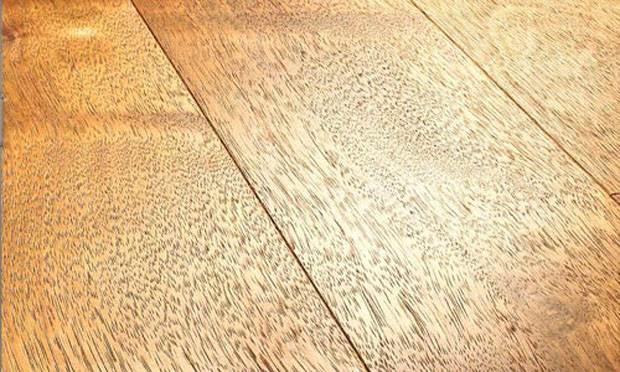
Cork parquet
The design of the locking plug is similar to the design of the laminate, and such a coating is assembled in exactly the same way. Since the coating turns out to be completely “unattached” to the base, such a cork floor is called “floating”.


